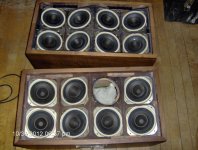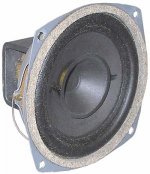hi
after acquiring a pair of Bifrons hox 05 speakers i'm interested in trying to determine if these boxes are indeed original or at some time in their history they've been re/hacked.
the pair are identical in construction but are two different finishes.also one of boxes had a driver missing.after examining these a little more closely they appear to be an assembly of 9 4 inch full range drivers in a quasi bose scheme 8 drivers on wrinkled baffle and one driver on the back i'm trying to confirm that the box wiring is original it appears that both are wired in a series parallel scheme 8+8+8=24 24/3=8 final but follow a pattern determined by string (series) and position in the box also after a little
research it seems these where originally designed for PA use which leaves me wondering if they originally came with x-formers.

after acquiring a pair of Bifrons hox 05 speakers i'm interested in trying to determine if these boxes are indeed original or at some time in their history they've been re/hacked.
the pair are identical in construction but are two different finishes.also one of boxes had a driver missing.after examining these a little more closely they appear to be an assembly of 9 4 inch full range drivers in a quasi bose scheme 8 drivers on wrinkled baffle and one driver on the back i'm trying to confirm that the box wiring is original it appears that both are wired in a series parallel scheme 8+8+8=24 24/3=8 final but follow a pattern determined by string (series) and position in the box also after a little
research it seems these where originally designed for PA use which leaves me wondering if they originally came with x-formers.
IIRC the Bose system that had nine drivers in it was wired with all in series and each speaker was 0.9 ohms.
0.9 x 9 = 8.1 ohms. Weird.
Check the DC resistance of all of the ones that are still wired and then isolate one driver and measure that.
A DC resistance will be lower than the nominal impedance, but not by a whole lot.
James.
0.9 x 9 = 8.1 ohms. Weird.
Check the DC resistance of all of the ones that are still wired and then isolate one driver and measure that.
A DC resistance will be lower than the nominal impedance, but not by a whole lot.
James.
Last edited:
isophons ? !
now although my quest for info on these is far from complete i have encountered some info that i'm still trying to get translated but from what i've garnered so far the parent company Electroakusztikal Gyar(now B.e.a.g. and still in the public address biz) originally designed the hox 05 hox 22 and other models in the hox line along with a slue of all kinds of other product aimed at the pro market throughout europe.and if the info i have is correct the use of isophons as a driver in these boxes either came before or after the introduction of the Bifrons line (their introduction to the consumer market back into the mid 70's) many more where marketed under the Janus logo which makes me wonder if these boxes where originally equipted with matching transformers for 70v or 100v (or even 25v) lines common practice for pa stuff
now although my quest for info on these is far from complete i have encountered some info that i'm still trying to get translated but from what i've garnered so far the parent company Electroakusztikal Gyar(now B.e.a.g. and still in the public address biz) originally designed the hox 05 hox 22 and other models in the hox line along with a slue of all kinds of other product aimed at the pro market throughout europe.and if the info i have is correct the use of isophons as a driver in these boxes either came before or after the introduction of the Bifrons line (their introduction to the consumer market back into the mid 70's) many more where marketed under the Janus logo which makes me wonder if these boxes where originally equipted with matching transformers for 70v or 100v (or even 25v) lines common practice for pa stuff
i'm still wondering about Daniel removing the rear facing driver. why?
and what did he do in terms of rewiring the box because from what i gather (assuming that the two i have are wired as intended) removing the rear driver means that the original scheme of three 8's in series by three legs in parallel for a final impedance of 8 doesn't jive any more
and what did he do in terms of rewiring the box because from what i gather (assuming that the two i have are wired as intended) removing the rear driver means that the original scheme of three 8's in series by three legs in parallel for a final impedance of 8 doesn't jive any more
OT: Some of the 901 series were like that. Others were 3 groups of 3.IIRC the Bose system that had nine drivers in it was wired with all in series and each speaker was 0.9 ohms.
Hello and sorry I didn't respond sooner.
I am the man with the Bifrons. I'm quite fond of these speakers but have modified them a bit to get them where they are now.
Mine came with the German Isophon drivers but many sets did indeed come with specially made drivers from BEAG. (I should mention here that BEAG and Elektroakusztikai Gyár are the same thing being that the full name is Budapesti Elektroakusztikai Gyár.)
The original wiring is three paralleled series sets of three which gives 8Ω from a set of nine 8Ω drivers. (8+8+8)/3
In my speakers I decided upon eight drivers per cabinet and 4Ω total operation. I did this by having two parallel sets of four in series; that is, take four drivers in parallel and stick that in series with another set of four in parallel. This gives 8/4+8/4 which is 4.
The original reason for removing the ninth driver was so that I could aperiodically load the cabinet. This involved applying an acoustic resistor to the hole from which came the driver. The effect is useful with high compliance drivers (like you see with old Goodmans fullrange stuff) to give better bass response.
To add to the effect, I have added 5g of mass to each driver. The mass component is a ring of ductseal formed into the terminus of the whizzer cone against the main cone. This adds mass which effectively reduces Fs and adds some damping to terminate transverse waves in the cone material. The effect, sonically speaking, is an improvement in transparency because of a lack of audible resonance in the driver. Some efficiency is lost but these are still extremely efficient speakers (a 10W amplifier is more than satisfactory, a 40W amplifier goes quite loud, and a 300W amplifier will take you to absolutely ear-bleeding levels).
At this point I have no more information on the BEAG Bifrons but I will mention that I'm interested in finding more sets. I ultimately would like to stack them four pairs high and wire them for OTL operation from a high current tube amplifier. All drivers in series, not counting rear drivers, would give 32 drivers and a total of 256Ω.
I'm also looking for more of the drivers for these speakers as I have managed to overheat one of mine; there's every now and then a barely audible buzzing which suggests the voice coil has lifted.
I am the man with the Bifrons. I'm quite fond of these speakers but have modified them a bit to get them where they are now.
Mine came with the German Isophon drivers but many sets did indeed come with specially made drivers from BEAG. (I should mention here that BEAG and Elektroakusztikai Gyár are the same thing being that the full name is Budapesti Elektroakusztikai Gyár.)
The original wiring is three paralleled series sets of three which gives 8Ω from a set of nine 8Ω drivers. (8+8+8)/3
In my speakers I decided upon eight drivers per cabinet and 4Ω total operation. I did this by having two parallel sets of four in series; that is, take four drivers in parallel and stick that in series with another set of four in parallel. This gives 8/4+8/4 which is 4.
The original reason for removing the ninth driver was so that I could aperiodically load the cabinet. This involved applying an acoustic resistor to the hole from which came the driver. The effect is useful with high compliance drivers (like you see with old Goodmans fullrange stuff) to give better bass response.
To add to the effect, I have added 5g of mass to each driver. The mass component is a ring of ductseal formed into the terminus of the whizzer cone against the main cone. This adds mass which effectively reduces Fs and adds some damping to terminate transverse waves in the cone material. The effect, sonically speaking, is an improvement in transparency because of a lack of audible resonance in the driver. Some efficiency is lost but these are still extremely efficient speakers (a 10W amplifier is more than satisfactory, a 40W amplifier goes quite loud, and a 300W amplifier will take you to absolutely ear-bleeding levels).
At this point I have no more information on the BEAG Bifrons but I will mention that I'm interested in finding more sets. I ultimately would like to stack them four pairs high and wire them for OTL operation from a high current tube amplifier. All drivers in series, not counting rear drivers, would give 32 drivers and a total of 256Ω.
I'm also looking for more of the drivers for these speakers as I have managed to overheat one of mine; there's every now and then a barely audible buzzing which suggests the voice coil has lifted.
- Status
- This old topic is closed. If you want to reopen this topic, contact a moderator using the "Report Post" button.
- Home
- Loudspeakers
- Full Range
- multiple driver speaker
 I think you tried to paste the image into your post, instead of the image URL. Can you point me to it so I can fix it?
I think you tried to paste the image into your post, instead of the image URL. Can you point me to it so I can fix it?
